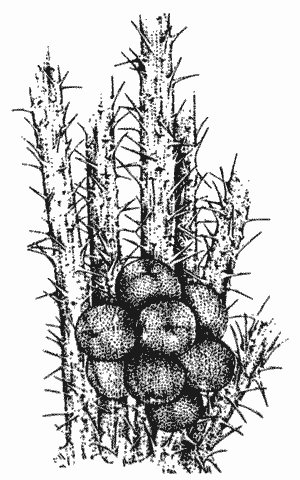From the Archives
of the Rare Fruit Council of Australia
by Michael McDonnell, Farm Advisory Manager

Salak Palm
Scientific
name: Salacca
zalacca, S. edulis
Family:
Arecaceae
The fruit is grown throughout Asia and is a stemless spiky palm
producing bunches of delicious fruit at the base. Each bunch contains
approximately 10 fruit, 5-7cm in diameter and individual fruits
resemble tanned crocodile leather in appearance. The tough leathery
skin protects the fruit from bruising. It travels well and has a good
shelf life. The flesh consists of several creamy-white sections, about
the consistency of macadamia nut, crunchy to bite, with a sweet-sour
pineapple-banana flavour. The flesh recovery is approximately 80%.
Each
palm produces 150 fruit approximately annually and there are about 10
fruits to the kilogram. In Asia, salak fruit is highly valued and
should have great export potential.
Salak fruit has a high
market acceptability, unique in appearance with an exquisite, exotic
flavour and could very easily become a new primary industry for Far
North Queensland. It has very restricted growing conditions and will
not tolerate frosts. Salaks have no known pests or diseases in
Australia and therefore can be grown without spraying and they have the
same retail value as mangosteen, approximately $16 per kg.
They
require a free-draining soil, with a high organic content. They need an
annual rainfall of 2000mm+ and 90mm in the driest month.
A
commercial salak plantation should be a minimum of 1000 palms of 1
hectare, each planted 2.5 metres apart in rows 4 metres wide or wide
enough for a small tractor. For the first 3 years, they require shade
either by way of shade cloth or shade trees, i.e. bananas, paw-paws or
tree grapes etc. By winter of the third year, the palms should be
flowering.
Regular dressings of N.P.K. is recommended,
also generous amounts of mulch. In a well-maintained orchard, the rows
between the salaks should provide all the mulch needed. Soil pH as
close to 7 as possible.
Salaks offer an exciting future for small and large scale farmers with
a sense of adventure.

Salak Palm Fact Sheet
Tree
Description
A small stemless spiky palm with fronds 4 metres in length.
Fruit
Description
Bunches
of fruit are produced at the base of the palms. Each fruit
approximately 5-7cm in diameter with a tanned crocodile leather
appearance. The tough skin prevents the fruit from bruising. It travels
well and has a good shelf life. The flesh consists of several
creamy-white sections resembling macadamia nut, crunchy to bite with a
sweet-sour pineapple-banana flavour. Flesh recovery approximately 80%.
Each palm produces 10 to 30 bunches per year, up to 20 fruits per bunch.
Fruiting Age
3 to 4 years
Frost
Tolerance: NIL
pH:
6-7
Sun Exposure
At least 30% shade for the first 3 years by way of shade cloth or shade
trees i. e. under existing fruit trees.
Drainage
Well-drained soil with permanent moisture.
Fertilizer
Generous amounts of N.P.K. four times a year. Calmas twice a year plus
a trace metal supplement annually and mulching.
Field Planting
1000 palms per hectare, 2.5 metres apart in 4 metre rows.
Propagation
There
are many different species of salak in Asia, most of which are either
male or female. Seed must be obtained from bi-sexual palms i.e. Gondok.
Market
Mainly fresh fruit market. In Asia they are pickled.
Pests and
Diseases - to date no known in Australia.
Soil
Preference - Tolerates a wide range of soils.
Commercial
Potential
In
Asia salaks are valued the same as mangosteen, and apart from a
domestic market, a great export potential exists. An over-supply of
this fruit is unlikely as the palms are difficult to grow. Formidable
thorns discourage most potential growers and only true exotic
fruit-growing fanatics with a sense of adventure will succeed with this
fascinating and delicious fruit.
Back to
Salak
Page
|
|

